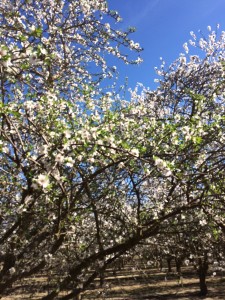
I have received a few reports about poor bloom conditions on ‘Nonpareil.’ In these cases, flower density appears to be low and leaves are starting to push (See Figure 1) indicating that the fruit buds did not develop over the past year. From the reports, trees tend to be between the ages of 6 and 12 years old and have been observed across Merced County.
A number of issues may be responsible, including the following:
- Water stress. Reductions in water resources over the past year have led to reduce vegetative growth in many orchards. This lack of growth prevents the formation of vegetative buds (in-season) which develop into fruit bud (post-harvest through dormant period). Research has shown that spurs that remain in good light positions tend to “take a year off” after bearing fruit, while others receiving too much shade die. Therefore, canopy growth must be maintained to some extent to keep crop loads high.
- Salinity Induced Water Stress. Increasing soil salinity decreases the osmotic potential of the soil, making the plant “work harder” for water. This leads to water stress and reduces the energy diverted into vegetative growth and floral bud development.
- High yields over the past few years. Trees producing large yields in successive years have been observed to have an “off year.” This is due to most of the plants energy being diverted into the crop load, reducing the amount available for developing new fruiting spur positions. As discussed earlier, if this happens in successive years, the number of viable fruit spurs may be reduced leading to a reduced crop.
- Re-leafing in the Fall after leaf drop from foliar disease, salt, or mites. Bloom density would be lower if the tree defoliated last summer or fall from lack of water, too high of salt levels, foliar disease, or insects and re-leafed after harvest. This process utilizes vegetative buds that have been developed earlier in the season, reducing the number of buds that will develop into fruit buds.
I have been asked if poor chilling could have caused the symptoms observed. It is possible. Based on the low chilling requirement for almonds and the patterns within the field, I dont, however, think this is the cause. If so, I would expect that all varieties and age of trees to be affected, and to observe odd bloom patterns within a field – such as the north side having a better bloom than the south.
Research referenced: Tombesi, S., B. Lampinen, S. Metcalf, and T. DeJong. 2011. Relationships between spur- and orchard-level fruit bearing in almond (Prunus dulcis). Tree Physiology. Vol.31, pgs 1413-1421.


Brendan Sidhu
February 17, 2015The Aussie experience confirms the data in your article. Prior to our drought we set some record crops. With server water restrictions in place most growers implemented a deficit irrigation program. This resulted in yield reductions for a number of years. I have quite a bit of data on our personal experience which we could share with you if you wish.
David Doll
February 18, 2015Thank you for sharing, Brendan. It is always great to have thoughts from the Aussie perspective. I would like to touch base with you regarding drought expectations. Ill be in touch through email.
David
02.18.2015 | Fowler Agency, LLC - Crop Insurance for Texas & Oklahoma Ranchers
February 18, 2015[…] California Almonds: More Leaves than Flowers: Why? […]
02.18.15 | MyAgri-Insurance.com-Crop Insurance
February 18, 2015[…] California Almonds: More Leaves than Flowers: Why? […]
Leigh Teitz
February 26, 2015Just following on from Brendan’s post, the other major issue caused by the drought in Australia was a significant decline in available boron levels (seen in hull samples) due to reduced soil availability. Dry winters in particular impact boron solubility resulting in lower available soil boron coming into flowering. Obviously this has potential to inhibit flowering and fruit set/nut retention.
Cheers
Leigh
David Doll
February 26, 2015Thanks for sharing, Leigh!
David